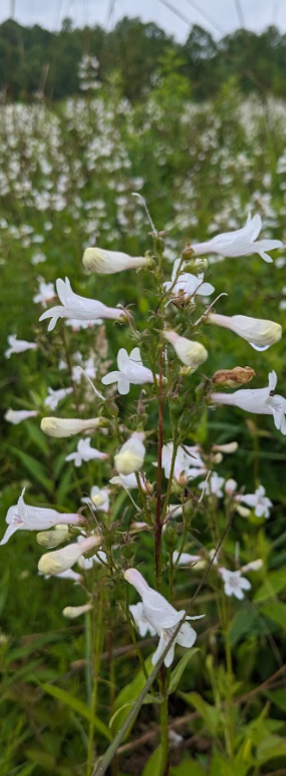- 2024 Native Trees
- >
- Herbaceous Plants
- >
- Foxglove Beardtongue (Penstemon digitalis)
Foxglove Beardtongue (Penstemon digitalis)
Height: 2 to 4 feet
Bloom Time: May to July
Bloom Description: Tubular white flowers atop a slender stalk
Sun: Full sun to part shade
Attracts: Bumblebees, long-tongued insects, specialized bees
Snapdragon Family
Native to Jefferson County
Foxglove Beardtongue is an late-spring bloomer that provides nectar and pollen in an important window where early spring flower blooms are fading but summer flowers have not yet fully begun to bloom.
If you watch closely the flowers of Foxglove Beardtongue, you will notice plenty of bumblebees frantically trying to squeeze their round bodies into the slender tubular white flowers. According to a post by Justin Wheeler on the Xerces Society blog, this is not by accident!
Justin writes “Foxglove beardtongue has a few interesting "design" features worth noting. Beardtongue derives its common name for the hairs that line the protruding lower petal of these tubular plants. These hairs serve an interesting function, forcing bees deeper into the flower. Some Penstemon species also have small protrusions in the flower interior that act like hooks, giving the bee a bit of a squeeze and making them struggle a tiny bit to escape. As they do so, the anthers of the flower wrap around the body of the bee, adhering pollen where it will be perfectly aligned to meet the stigma of the next flower. If you look into the tubular flowers you’ll notice several distinct lines leading to the back of the flower known as nectar guides. These lines act like runway lights, advertising to bees that “the good stuff is back here!”
Foxglove Beardtongue is a clump-forming perennial. Rosettes of leaves one to two feet in width send up slender stalks that culminate in tubular white flowers. Seedheads produced late in the season are attractive to songbirds, including chickadees, titmice, vireos, and nuthatches.
In a natural setting, Foxglove Beardtongue can be found growing in a variety of settings, including old fields, roadsides, rail corridors and woodland openings. Plants flourish in sunny sites consisting of fertile, moist, well-drained, slightly acidic, loamy soils.
A variety of insect species are attracted to the flowers, including bumblebees, specialized bees such as leafcutter bees and sweat bees, hummingbird moths, and butterflies. Hummingbirds are also frequent diners. Foxglove Beardtongue is a host plant for ten species of moth and butterfly caterpillars. ■



